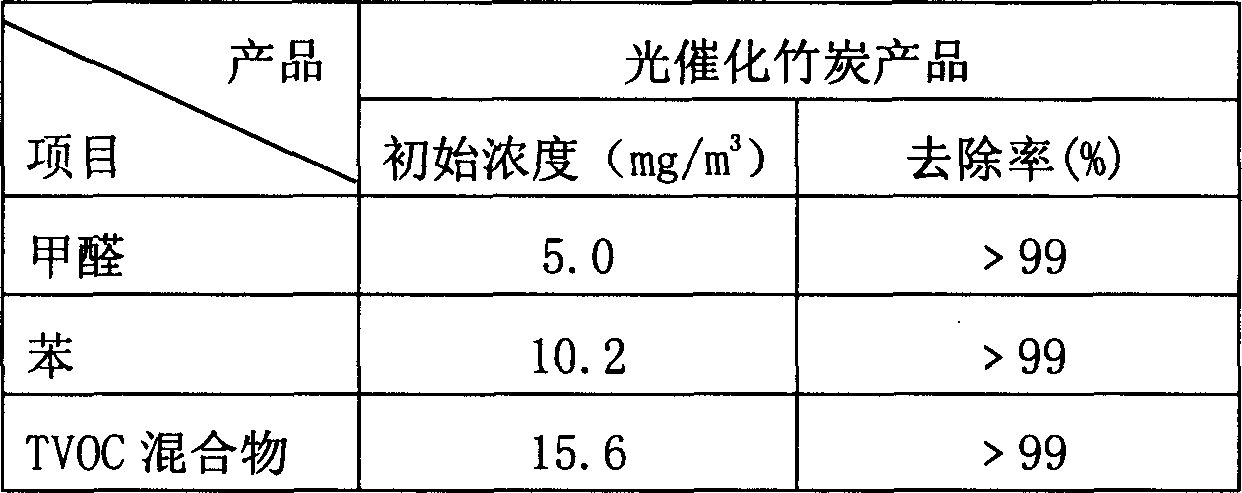Nanometer modified photocatalytic bamboo charcoal
A nano-modification and photocatalysis technology, which is applied in the direction of physical/chemical process catalysts, other chemical processes, chemical instruments and methods, etc., can solve the problems of low light utilization rate, narrow response wavelength, poor adsorption and decomposition effect, etc. The effect of low utilization
- Summary
- Abstract
- Description
- Claims
- Application Information
AI Technical Summary
Problems solved by technology
Method used
Image
Examples
Embodiment 1
[0039] 1. Implement hybridization and red-shift technology on anatase nano-titanium dioxide, that is, prepare modified anatase nano-TiO by liquid phase gel method 2 Material.
[0040] Dissolve the alkoxide in TiO 2 and metal ions (platinum, iron, nickel) in organic solvents (among them, alkoxides, TiO 2 The mass ratio of metal ions (platinum, iron, nickel) is 0.4-0.6: 1: 0.1-0.2: 0.3-0.4: 0.2-0.3).
[0041] By adding distilled water to hydrolyze the alkoxide to form a sol, and to obtain a gel after gelation treatment, so that the metal ions and TiO 2 The particle surfaces recombine to form a compound semiconductor.
[0042] After drying and roasting at about 60°C-100°C, the modified anatase nano-TiO can be obtained. 2 Materials (trade name "Tifull", Shanghai Titanium Nano Technology Co., Ltd.).
[0043] The material is catalytic and can respond to light with a wavelength close to 800 nanometers, has higher photocatalytic activity, and has dark photocatalytic effect.
[0...
Embodiment 2
[0062] In addition to the modified anatase nano-titanium dioxide aqueous solution (concentration of 6-7%) improved by the hybrid redshift technology, which is uniformly coated on the surface of Phyllostachys pubescens and in the pore wall at a mass ratio of 1-3:500, other As in Example 1, the obtained photocatalytic bamboo charcoal particles have a diameter of 6-10 millimeters, and are made into various massive photocatalytic bamboo charcoal cakes such as spherical or block, wherein:
[0063] Fixed carbon component: 80 to 85% by mass
[0064] Titanium dioxide: 0.2 to 0.6% by mass
[0065] The rest are water, volatile matter, uncarbonized matter, etc.
Embodiment 3
[0067] In addition to the modified anatase-type nano-titanium dioxide aqueous solution (concentration of 5-7%) after the implementation of the hybrid redshift technology is uniformly coated on the surface of Moso bamboo and in the pore wall at a mass ratio of 1-2.5:500, other As in Example 1, the prepared photocatalytic bamboo charcoal is pressed into spherical or block photocatalytic bamboo charcoal cakes of various shapes, wherein:
[0068] Fixed carbon component: 80 to 85% by mass
[0069] Titanium dioxide: 0.2 to 0.5% by mass
[0070] The rest are moisture, volatile matter, ash and uncarbonized matter.
[0071] Tested by Shanghai Environmental Protection Product Quality Supervision and Inspection Center, the physical and chemical performance indicators of the finished product adsorption, decomposition, sterilization, purification, and recyclable photocatalytic function-enhanced bamboo charcoal materials are as follows:
[0072] Appearance: black particles
[0073] The m...
PUM
| Property | Measurement | Unit |
|---|---|---|
| diameter | aaaaa | aaaaa |
| diameter | aaaaa | aaaaa |
| diameter | aaaaa | aaaaa |
Abstract
Description
Claims
Application Information
 Login to View More
Login to View More - R&D
- Intellectual Property
- Life Sciences
- Materials
- Tech Scout
- Unparalleled Data Quality
- Higher Quality Content
- 60% Fewer Hallucinations
Browse by: Latest US Patents, China's latest patents, Technical Efficacy Thesaurus, Application Domain, Technology Topic, Popular Technical Reports.
© 2025 PatSnap. All rights reserved.Legal|Privacy policy|Modern Slavery Act Transparency Statement|Sitemap|About US| Contact US: help@patsnap.com

